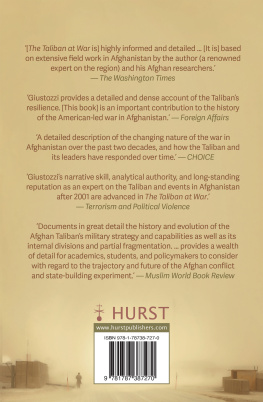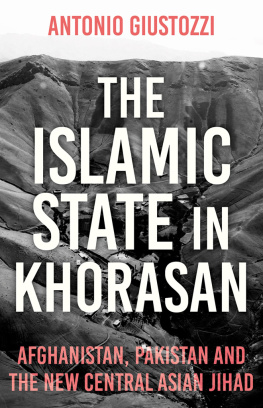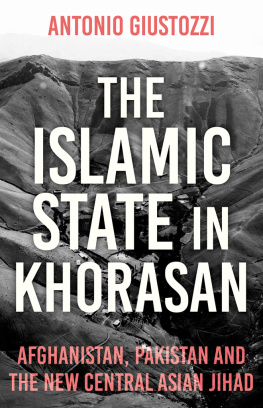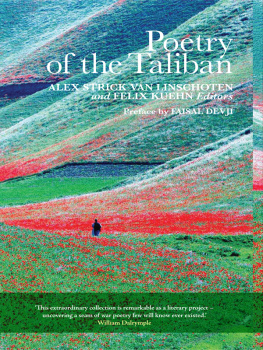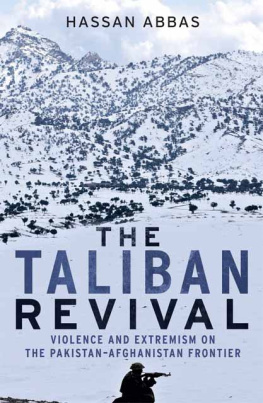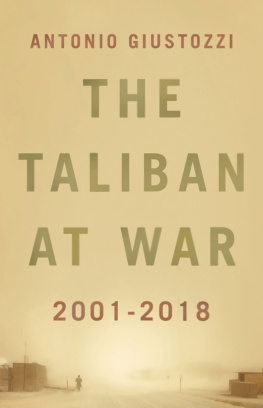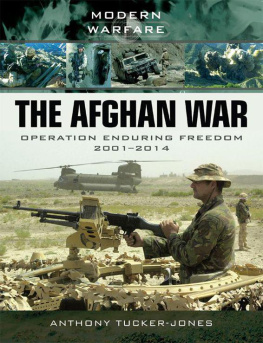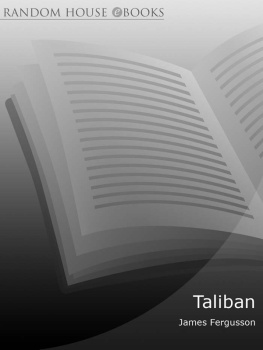Giustozzi Antonio - The Taliban at War (2001-2021)
Here you can read online Giustozzi Antonio - The Taliban at War (2001-2021) full text of the book (entire story) in english for free. Download pdf and epub, get meaning, cover and reviews about this ebook. year: 2022, publisher: Hurst Publishers, genre: Politics. Description of the work, (preface) as well as reviews are available. Best literature library LitArk.com created for fans of good reading and offers a wide selection of genres:
Romance novel
Science fiction
Adventure
Detective
Science
History
Home and family
Prose
Art
Politics
Computer
Non-fiction
Religion
Business
Children
Humor
Choose a favorite category and find really read worthwhile books. Enjoy immersion in the world of imagination, feel the emotions of the characters or learn something new for yourself, make an fascinating discovery.
- Book:The Taliban at War (2001-2021)
- Author:
- Publisher:Hurst Publishers
- Genre:
- Year:2022
- Rating:5 / 5
- Favourites:Add to favourites
- Your mark:
- 100
- 1
- 2
- 3
- 4
- 5
The Taliban at War (2001-2021): summary, description and annotation
We offer to read an annotation, description, summary or preface (depends on what the author of the book "The Taliban at War (2001-2021)" wrote himself). If you haven't found the necessary information about the book — write in the comments, we will try to find it.
The Taliban at War (2001-2021) — read online for free the complete book (whole text) full work
Below is the text of the book, divided by pages. System saving the place of the last page read, allows you to conveniently read the book "The Taliban at War (2001-2021)" online for free, without having to search again every time where you left off. Put a bookmark, and you can go to the page where you finished reading at any time.
Font size:
Interval:
Bookmark:

THE TALIBAN AT WAR, 20012021
ANTONIO GIUSTOZZI
The Taliban at War
20012021

HURST & COMPANY, LONDON
First published in the United Kingdom in 2019 by
C. Hurst & Co. (Publishers) Ltd.,
41 Great Russell Street, London, WC1B 3PL
This paperback edition first published in 2022 by
C. Hurst & Co. (Publishers) Ltd.,
New Wing, Somerset House, Strand, London, WC2R 1LA
Antonio Giustozzi, 2022
All rights reserved.
Printed in the United Kingdom
The right of Antonio Giustozzi to be identified as the author of this publication is asserted by him in accordance with the Copyright, Designs and Patents Act, 1988.
A Cataloguing-in-Publication data record for this book is available from the British Library.
ISBN: 9781787387270
www.hurstpublishers.com
CONTENTS
ACKNOWLEDGEMENTS
This book is the result of a research project carried out with Kings College London (KCL) and funded by the Economic and Social Sciences Research Council (or ESRC, with the project entitled The Talibans War: The Other Side of the Afghan Conflict, 20012015, ESRC Grant ES/L008041/1). Thanks to the ESRCs support, it was possible to carry out extensive fieldwork. The project was carried out with the support of Professor Theo Farrell, then Head of the War Studies Department at KCL (he has since moved on), whose help was invaluable in preparing the proposal to the ESRC and who then steered the research effort towards its timely and successful completion. Professor Farrell also contributed to the processing of the interview transcripts, played a key role in quality control and enforced ethical and safety standards. Finally, he commented extensively on the first version of the manuscript.
The book has also benefited from work completed for related projects, covering specific aspects of the Talibans activities and organisation. This includes another project carried out with Professor Farrell on the Taliban in Helmand, which provided the model for this book, and important work carried out with Claudio Franco in 201114 on the Talibans Peshawar Shura.
The author thanks all those involved, especially the Afghan researchers, who for safety reasons will remain unnamed, as well as all those in KCLs administration who supported the research effort. Many thanks also to all who commented on the text, in particular Professor Thomas H. Johnson at the Naval Postgraduate School and other anonymous reviewers. The author also wishes to thank Michael Dwyer and everybody else at Hurst Publishers.
The author furthermore thanks all those who contributed to the development of his ideas and views on the subject in countless meetings, workshops and conferences. They are far too numerous to be individually mentioned here.
Naturally, the author assumes all responsibility for the analysis contained in this text, and any errors remain his own.
INTRODUCTION
The Taliban Emirate, established in 1996, was in 2001 overthrown relatively easily by a coalition of US forces and various Afghan anti-Taliban groups. Few at the end of 2001 expected to hear again from the Taliban, except in the annals of history. Even as signs emerged in 2003 of a Taliban comeback, in the shape of an insurgency against the post-2001 Afghan government and its international sponsors, many did not take it seriously. It was hard to imagine that the Taliban would be able to mount a resilient challenge to a large-scale commitment of forces by the US and its allies.
How the Taliban re-emerged
Its not easy being in the Taliban. Its like wearing a jacket of fire. You have to leave your family and live with the knowledge that you can be killed at any time. The Americans can capture you and put you in dog cages in Bagram and Guantnamo. You cant expect any quick medical treatment if youre wounded. You dont have any money. Yet when I tell new recruits what they are facing they still freely put on this jacket of fire. All this builds my confidence that we will never lose this war.
During 200913 the Taliban stood against a much larger force, with the US contribution to the coalition amounting at one point to over 100,000 men. With US funds, the Afghan security forces increased to over 300,000 men by 2014, and US allies contributed tens of thousands of additional combat troops. The Talibans enemies, particularly the Americans, had immense superiority in terms of technology and firepower; airpower in particular inflicted heavy
As coalition combat forces mostly withdrew in 2014, though the Taliban could not claim to have yet won the war, they had achieved a lot by not losing it. As of 2019 the war continues, but the survival and growth of the Taliban during 200213 (after which they could profit from the reduction of coalition troop levels) is a question deserving an explanation, which this book seeks to provide.
The Taliban claim that their moral righteousness, in serving the cause of Islam, has allowed them to surmount all these challenges. Though high morale has undoubtedly been a factor, this book investigates other explanations as well. It looks at the way the Taliban organised militarily and how that organisation evolved. It looks at how and whom the Taliban recruited. It looks at their tactics, including the innovation and adaptation that took place and how that was managed by the leadership.
This is not, however, a book of pure military history. It is also a political history of this group, and in particular of how they transformed organisationally. As will become clear, for the Taliban (perhaps even more than for most other organisations) organisational adaptation was a painful process, with major political implications. The groups different components viewed organisational adaptation through different lenses, depending on the particular set of interests they were defending. The outcome of this organisational adaptation, in other words, cannot be simply explained as a reactive adaptation to external challenges. It was a deeply political debate that shaped the the peculiars of how the Taliban adapted, making it sub-optimal from a purely military-technocratic point of view. In this sense the point of departure is that adopted by Weinstein in his Inside Rebellion, where he argues that the environment faced by insurgents shapes their violence, though this work expands the argument to include the Talibans internal debates as a key component of the story.
This volume has benefited from a body of published literature. The relationship with Al-Qaida, the Talibans most important external link, is
This work has also relied upon existing discussions of external support for the Taliban, though these are few; the most detailed treatment remains Matt Waldmans 2010 article.
Accounts of western military engagements with the Taliban proved useful in understanding the groups operations, the foremost example being Theo Farrells Unwinnable.
Why focus on the military organisation?
The extreme complexity of the Talibans organisational apparatus is the reason for the focus on a sole field of activity, arguably the most important for an insurgency: the military. Inevitably it was not possible, and it would have been misleading, to completely insulate the military aspect from the surrounding politics, and from other organisational aspects such as finance. The focus, however, is primarily on the military and its adaptation. Despite this limiting of this studys scope, one should not forget that the Taliban invested considerable human and financial resources in non-military activities, most notably their judiciary, but also in education, propaganda and various governance activities. Occasional refence is made throughout the book to these, though space does not permit a detailed discussion.
Font size:
Interval:
Bookmark:
Similar books «The Taliban at War (2001-2021)»
Look at similar books to The Taliban at War (2001-2021). We have selected literature similar in name and meaning in the hope of providing readers with more options to find new, interesting, not yet read works.
Discussion, reviews of the book The Taliban at War (2001-2021) and just readers' own opinions. Leave your comments, write what you think about the work, its meaning or the main characters. Specify what exactly you liked and what you didn't like, and why you think so.

